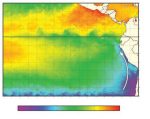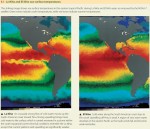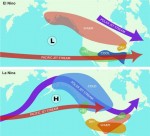
How Does an El Niño Start and Stop?
THE ENSO PHASES, EL NINO AND LA NINA, have profound impacts throughout the Pacific basin and neighboring continents. What begins as a local adjustment in sea level and depth of the thermocline in the western Pacific can spread across the equatorial Pacific, triggering an El Nino. Once established, an El Nino directly impacts weather in […]

What Are the Phases of ENSO?
THE ATMOSPHERE OCEAN SYSTEM in the equatorial Pacific is constantly changing. Although each year has its own unique characteristics, certain atmosphere-ocean patterns repeat, displaying a limited number of modes. We can use surface-water temperatures in the eastern equatorial Pacific to designate conditions as one of three phases of the El Nino-Southern Oscillation (ENSO) system — […]

What Are El Niño and the Southern Oscillation?
THE MOST WELL KNOWN AND PUBLICIZED cause of climate variability, floods, droughts, hurricanes, heatwaves, and landslides is a change in the strength of winds and ocean currents west of South America in what has become known as El Nino. El Nino is one expression of the ocean-atmosphere system operating over and within the equatorial Pacific […]
El Nino Wreaks Havoc
The complex, interrelated geology of the Andes, the Atacama Desert, and the Atacama Trench all come together in the face of El Nino, a weather pattern that affects the whole planet. The microscopic plankton that grow in the sunlit waters of the upper ocean provide the foundation for the ocean's food chain, just as grass […]

El Nino and La Nina
Moody, tempestuous, violent: it's so easy to assign human qualities to El Nino and its companion, La Nina. This pair of atmospheric cycles broke into the news in the late 1990s when a remarkably strong El Nina wreaked global havoc. The pithy name fits well with headlines, and the concept – a strange, portentous warming […]
The people who know El Nino best
In Spanish, El Nino means 'the male infant” or, when capitalized, the Christ child. Peruvians began applying the term to the ocean and atmosphere more than a century ago. Navy captain Camilo Carrillo noted in 1892 that local sailors referred to a periodic warming of the Pacific, which often occurred around Christmas, as El Nino. […]

Nino or Nina?
El Nino has hit the headlines as a codeword for bad weather, especially in the Pacific and California. But there is a little more to it than that. The name El Nino might suggest a relatively benign phenomenon. Would the devout Catholics of Latin America call something after the Baby Jesus if it was particularly […]

El Nino
At irregular intervals of about three to eight years, a remarkable disturbance of ocean and atmosphere occurs in the equatorial Pacific region—El Nino. Its name comes from Peruvian fishermen, who refer to the Corriente del Nino or the “Current of the Christ Child,” to describe an invasion of warm surface water once every few years around Christmas time that greatly depletes their […]

El Nino and La Nina
EL NINO AND La Nina are parts of global weather systems that recur every two to seven years. An El Nino, which usually lasts 12 to 18 months, is characterized by warm winters and wet springs in North America, a lessening of monsoonal rains in Asia, and droughts affecting Africa and the south PACIFIC OCEAN. […]